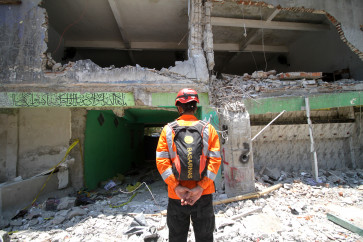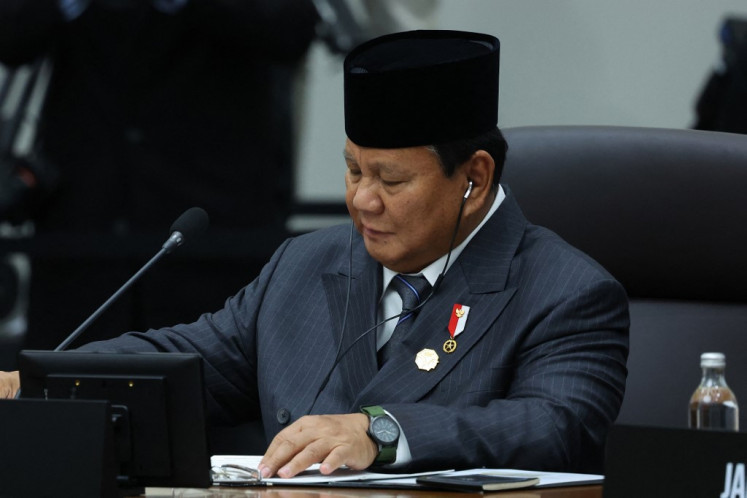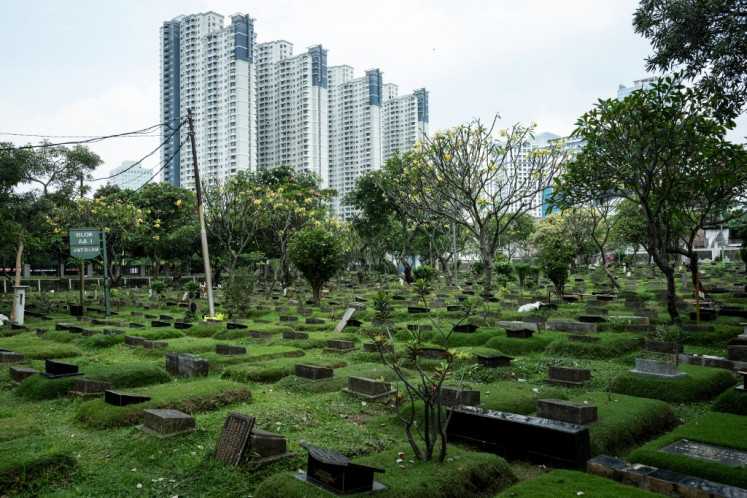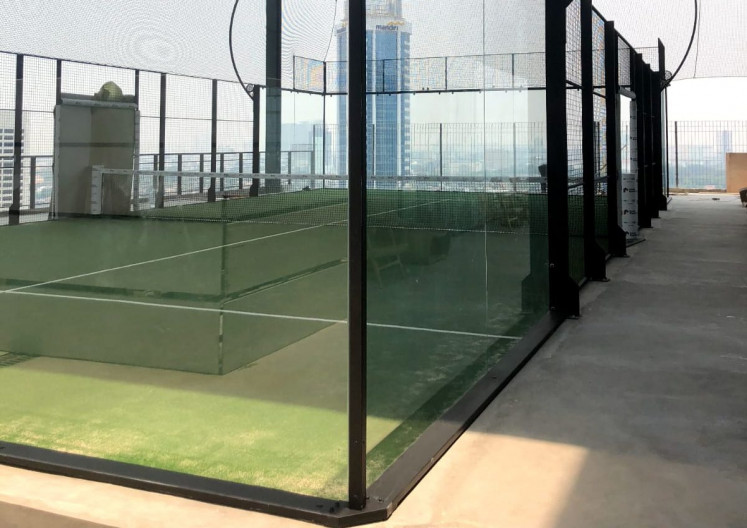Popular Reads
Top Results
Can't find what you're looking for?
View all search resultsPopular Reads
Top Results
Can't find what you're looking for?
View all search resultsNew cases, deaths soar as COVID-19 patients pile up in hospitals
Change text size
Gift Premium Articles
to Anyone
I
ndonesia must contend with new confirmed COVID-19 cases and deaths that are concentrated in several regions across the country, putting a strain on local healthcare facilities.
The country saw on Wednesday another record-breaking 5,535 new cases of COVID-19, shattering the previous daily record. Leading the way are two provinces that reported four-digit growth: the Jakarta capital region and Central Java, with 1,273 and 1,008 new cases respectively.
During a virtual media briefing on Wednesday, the head of the Central Java Health Agency, Yulianto Prabowo, said that hospitals in several regions were seeing their occupancy rates soar.
At least 253 out of the available 402 intensive care unit (ICU) beds in the region had been occupied as of Tuesday, Yulianto said.
He noted, however, that the referral system was still in place and that other hospitals were still available.
Health Ministry data as of Monday show the bed occupancy rate for COVID-19 treatment at 77 percent in Central Java, 75 percent in West Java and 73 percent in Banten. The rate in Yogyakarta remains 66 percent, followed by 60 percent in Jakarta, 59 percent in Lampung and 56 percent in East Java. The occupancy rate in Jakarta does not take into account the Wisma Atlet makeshift hospital and isolation center, which can usually fit up to 1,800 people per tower.
West Java reported 741 new cases on Wednesday, while East Java saw 402 and Yogyakarta 150. Outside Java, North and West Sumatra reported 260 and 236 new cases respectively and East Kalimantan reported 190.
One of the reasons for the uptick in cases in Central Java was the long weekend holiday in late October. During this period, people tended to forgo social distancing measures, Yulianto said. He also claimed the increase was the result of an increase in the number of people who got tested.
“During the long holiday, [people are usually homeward bound], which increases mobility from Jakarta and West Java to Central Java. Whenever there’s an exodus, Central Java is among the most affected,” he said.
New infection clusters have mainly emerged from either households with a history of recent travel or when they are defined as imported cases. Following closely are Islamic boarding schools, which owe most of their cases to local transmission or exposure at traditional markets.
There are also smaller clusters of civil servants, military personnel and medical workers, as well as clusters at workplaces, public events and schools.
Yulianto appeared to be downplaying concerns that hospitals might be overwhelmed. He said hospitals were adding 508 more isolation beds to accommodate the influx of patients, and insisted there was a sufficient number of medical workers to handle the spike in cases.
The Wisma Atlet makeshift hospital in Jakarta, meanwhile, saw its bed occupancy rate spike to 74.22 percent as of Monday, a gradual increase from when it dipped to 32 percent on Nov. 5, according to Health Ministry data. The capital also saw several clear violations of health protocols recently, including the mass gatherings involving firebrand cleric Rizieq Shihab.
In West Java, the head of the local health agency, Berli Hamdani, told the Post on Tuesday that there was an increase in COVID-19 in-patients at its referral hospitals. The majority of them, some 75 percent, were distributed across Greater Jakarta cities Bogor, Depok and Bekasi, followed by Greater Bandung. Berli said that hospitals would anticipate the surge by increasing their capacity.
Yogyakarta, meanwhile, recorded 1,176 active cases as of Wednesday, with only nine vacant ICU beds out of a total of 49, and 48 empty isolation beds out of 404.
One of the region’s COVID-19 referral hospitals, RSUP Dr. Sardjito Hospital, saw an increase in COVID-19 patients. All 18 of its ICU beds were occupied as of Tuesday, while 25 of the 38 isolation beds were taken, said Banu Hermawan, the hospital’s spokesman.
As for deaths, East Java continues to log the highest number of daily COVID-19 deaths with 34 as of Wednesday, totaling 4,249 fatalities. This is higher than Jakarta's 2,578 deaths, despite only recording half as many cases. East Java’s figure accounts for a quarter of nationwide fatalities, which stands at 16,225.
For Central Java, there is still a substantial gap between the number of deaths logged on its official website and the figure that is released daily by the central government.
As of Wednesday, the province’s website revealed it had recorded 36 new deaths, bringing the total to 3,387 fatalities. Meanwhile, the central government recorded just nine new deaths, totaling 2,162 fatalities. More than 1,000 deaths, the discrepancy between central and regional datasets, remain unaccounted for.
Central Java’s Yulianto suggested that the website was providing real-time data, while data from the central government would go through some scrubbing to verify whether or not the deceased had tested positive for the virus.
"I don't think it should be a problem so long as each party can take responsibility for the data. We'll try to narrow the gap, but most important for now is for us to be honest," he said.
Joni Wahyuhadi, the curative management head of the East Java COVID-19 task force, did not acknowledge the higher number of deaths. He said the task force had already put in the effort to suppress the death rates.
"We're performing an audit on the deaths with the Health Ministry from many aspects, including the recording and reporting systems,” he told the Post on Tuesday.
Bambang Pujo Semedi, the ICU head at East Java's main COVID-19 referral hospital, Dr. Soetomo, said that further studies were needed to identify the factors behind the region’s high death rate. He suspected that the quality of care for critical and severe cases was partly to blame.
Pujo also pointed to the uneven distribution of capable medical workers such as ICU nurses as a problem even prior to the pandemic. Even at his large training hospital, he said there were difficulties in meeting the 1:1 ratio of ICU patients to nurses.
The ICU bed occupancy rate dipped from full capacity to around 60 percent in September. As a result, however, not everyone who needed an ICU bed could get one, as doctors had to be selective and prioritize.
Pujo said that up until July, the fatality rate among patients at Dr. Soetomo Hospital receiving COVID-19 treatment in the ICU was 70 percent, before going down to 46 percent in early November. The dip is the result of the hospital opting for high-flow nasal cannula therapy as a means to reduce ventilator use. Even so, procuring more advanced devices would change very little without adding capable personnel to interpret patients’ conditions and act on them at the earliest possible time, he said.
As such Pujo found it more important to focus on propping up the care system, especially for critical and severe cases of infection, rather than funneling resources toward medication.
Timely diagnostics, which would allow for prompt decision-making and better ensure the safety of medical personnel, remained an issue, Pujo said, especially as patients often only sought treatment at a severe stage.










